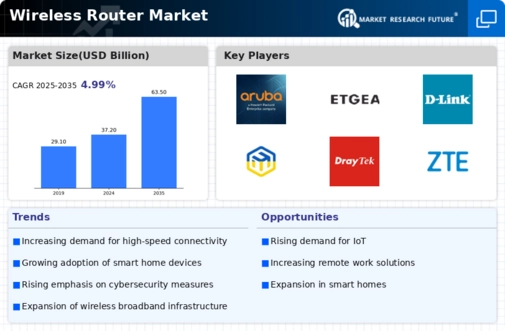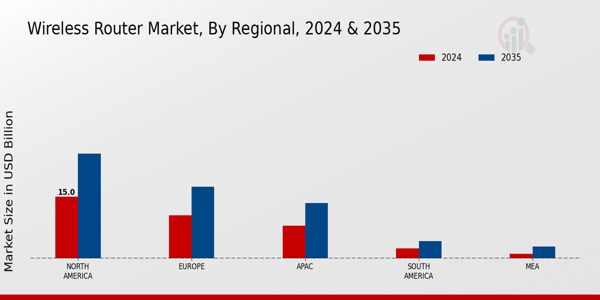Market Growth Projections
The Global Wireless Router Market Industry is projected to experience substantial growth over the next decade. With a market value of 37.2 USD Billion anticipated in 2024, the industry is expected to expand to 63.5 USD Billion by 2035. This growth reflects a compound annual growth rate (CAGR) of 4.99% from 2025 to 2035, indicating a robust demand for wireless routers driven by technological advancements and changing consumer behaviors. The market's trajectory suggests that stakeholders should prepare for evolving trends and invest in innovative solutions to capture emerging opportunities.
Emergence of 5G Technology
The emergence of 5G technology is poised to transform the Global Wireless Router Market Industry. With its promise of ultra-fast internet speeds and low latency, 5G is expected to enhance the performance of wireless routers significantly. This technology enables routers to support a higher number of connected devices, catering to the increasing demand for bandwidth-intensive applications such as streaming and gaming. As 5G networks become more widespread, the market is likely to witness a shift towards routers that can leverage this technology, thereby driving growth and innovation in the wireless router sector.
Expansion of Smart Home Technologies
The rise of smart home technologies significantly influences the Global Wireless Router Market Industry. As consumers adopt smart appliances, security systems, and home automation devices, the demand for robust wireless routers increases. These routers serve as the backbone of smart home ecosystems, ensuring stable connectivity for various devices. The market is expected to grow as more households integrate smart technologies, with projections indicating a market value of 63.5 USD Billion by 2035. This trend suggests that manufacturers must innovate to provide routers that can handle the increased data traffic generated by interconnected devices.
Increased Adoption of Cloud Computing
The increasing adoption of cloud computing solutions is a significant driver for the Global Wireless Router Market Industry. As businesses migrate their operations to the cloud, the demand for reliable and high-speed internet connectivity intensifies. Wireless routers are essential for facilitating access to cloud-based applications and services, which are becoming integral to modern business operations. This trend indicates a growing need for advanced routers capable of handling high data volumes and ensuring secure connections. The market's growth trajectory suggests that manufacturers will need to focus on developing routers that can meet the evolving demands of cloud computing.
Growth of E-commerce and Online Services
The ongoing expansion of e-commerce and online services plays a crucial role in shaping the Global Wireless Router Market Industry. As more consumers turn to online shopping and digital services, the need for reliable internet connectivity becomes paramount. This shift is likely to drive the demand for high-performance wireless routers that can support multiple users and devices simultaneously. With a projected compound annual growth rate (CAGR) of 4.99% from 2025 to 2035, the market is poised for sustained growth, as businesses and consumers alike seek to enhance their online experiences through improved connectivity.
Increasing Demand for High-Speed Internet
The Global Wireless Router Market Industry experiences a surge in demand for high-speed internet connectivity, driven by the proliferation of smart devices and the growing trend of remote work. As households and businesses increasingly rely on seamless internet access, the market is projected to reach 37.2 USD Billion in 2024. This demand is further fueled by advancements in technology, such as Wi-Fi 6, which offers enhanced speed and efficiency. The need for reliable and fast internet connections is likely to propel the growth of the wireless router market, as consumers seek devices that can support multiple devices simultaneously without compromising performance.












